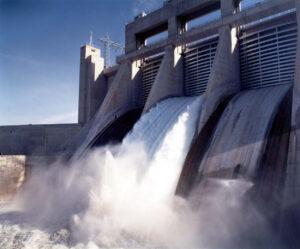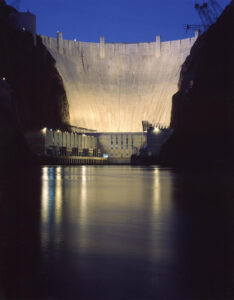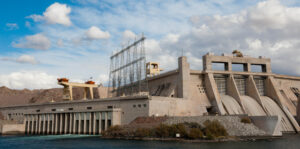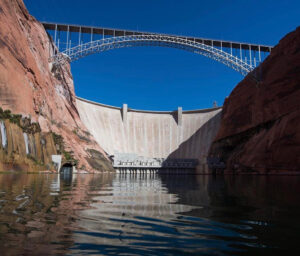Since 1902, the Bureau of Reclamation has played a crucial role in bringing water and power to the western United States. Many of the Reclamation dams that provide flood control services or surface water also generate hydroelectric power for millions of homes and businesses. In his three decades with Reclamation, Max Spiker has been at the forefront of the bureau’s hydropower efforts. From his early role as a mechanic to his current position of senior advisor for hydropower and electric reliability officer, he has been involved in maximizing’s Reclamation’s hydropower efforts. In this interview, Mr. Spiker tells Hydro Leader how Reclamation provides hydropower across the West, the advantages of hydro as a renewable energy resource, and Reclamation’s role as a hydropower provider in the future.
Hydro Leader: Please tell us about your background and how you came to be in your current position.
Max Spiker: As of this March, I’ve been at Reclamation for 33 years. I started in college and gravitated to working full time in power plant maintenance, eventually coming to be a hydroelectric mechanic at Hoover Dam. In general, my first 10 years at Reclamation were spent working in power plant maintenance. My second 10 years were spent in management and supervision of facilities. Since then, I’ve spent over a decade in the Reclamation Power Resource Office, which is the agency’s hydropower program office. I’ve worked as a program analyst and as the manager of the Power Resource Office, and currently I am the senior advisor.

Hydro Leader: What are your responsibilities in that position?
Max Spiker: I lead the oversight of the programmatic functions of Reclamation’s hydropower program—not only the policies, but also the initiatives implemented within Reclamation’s hydropower program to ensure that we produce reliable and cost-efficient power. I work with our customers to ensure that our facilities are maintained at operational and reliable levels to provide the value our customers expect and deserve.
Hydro Leader: How many Reclamation employees are directly associated with the hydro program?
Max Spiker: Reclamation has approximately 5,300 total employees, and approximately 1,600 of them directly support the hydropower program.
Hydro Leader: What role does Reclamation’s hydro program play in our nation’s overall power supply?
Max Spiker: Over the past century, federal hydropower generated at Reclamation projects has served project loads, enabling Reclamation to manage western water supplies. The surplus energy that goes beyond project load requirements is marketed by the U.S. Department of Energy’s power marketing administrations, providing Reclamation a steady stream of revenue for project repayment and investment.
Today, Reclamation is the second-largest producer of hydroelectric power in the United States. It owns 78 facilities in total. Of those 78, Reclamation directly operates and maintains 53 with its own staff. We call those 53 facilities reserved works. Those 53 facilities account for about 14,700 megawatts of capacity. On average, Reclamation’s reserved works facilities generate about 40 million megawatt-hours of clean and renewable electricity each year. For context, each year Reclamation’s hydropower program displaces over 18 million tons of carbon dioxide that would otherwise have been generated by traditional fossil fuel plants and generates an amount of energy equivalent to the demand of over 3.8 million U.S. households. We account for approximately 15 percent of United States’ hydropower capacity and generation.
Hydropower generated at Reclamation projects has provided tremendous value to the United States by developing and managing water supplies in the arid West and delivering reliable, low-cost, clean energy to our customers. Reclamation remains committed to our long-standing mission.
Hydro Leader: Are there any additional benefits or challenges of hydropower that you’d like to discuss?

Max Spiker: Hydropower is a clean, renewable energy resource. Hydropower is generated through the nonconsumptive use of water, and the water that flows through the turbines is available for downstream use and is naturally replenished by snow and rainfall. Hydropower delivers clean energy, domestic energy security benefits, energy storage, and job opportunities. There’s a lot to love.
Hydropower is also a dynamic energy resource, uniquely fitted to deliver both firm, dispatchable electric power and ancillary services. It supports safe, reliable energy transmission and the integration of intermittent, nondispatchable renewable energy resources into the grid. Hydropower ancillary services include frequency, voltage, and ramping capability services; resource flexibility services, such as load following; condensing; rapid startup times; and black start. Reclamation’s hydropower program is poised to play a critical role in the clean energy and climate change discussions that are currently ongoing.
Unfortunately, hydropower’s environmental and energy benefits are not fully valued a lot of the time in current energy markets. For example, there are only limited revenue streams for ancillary services, and large or existing hydropower facilities are often excluded from state renewable energy portfolio standards. In addition, Reclamation’s hydropower program is experiencing rate pressures in select markets. Factors including hydrologic variability, long-term drought, and operational constraints have collectively limited our generation and resource flexibility. At the same time, we’re managing increases in investment needs to keep our facilities reliable and dependable, as well as incremental costs allocated to hydropower for environmental mitigation activities. The result is less generation to recover more costs. Simultaneously, we’re operating in an increasingly competitive energy market, marked by abundant low-cost natural gas and cost-competitive nonhydropower renewables.
These operating conditions and shifting energy market dynamics present both challenges and opportunities for Reclamation’s hydropower program. In response, Reclamation has developed a hydropower program strategic plan that establishes our hydropower program vision and includes complementary goals and objectives, such as prioritizing the value of Reclamation’s hydropower, maintaining customer satisfaction, and investing in our workforce.
The strategic plan will allow Reclamation to better navigate shifting operational conditions and market dynamics, ensuring the long-term viability of Reclamation’s hydropower program.
The strategic plan is available on the Reclamation hydropower program website, which can be found at www.usbr.gov/power/.
Hydro Leader: Would you tell us about Reclamation’s role in providing power during extreme weather events?
Max Spiker: In August 2020, Reclamation responded to unusually high energy demands across the western United States, demonstrating hydropower’s integral role as a renewable, reliable, clean source of electricity that provides great value to the West and protects our nation’s energy security.
For example, our Glen Canyon, Hoover, Davis, and Parker facilities ramped up power production to respond to California’s electric emergency and to help stabilize the western electrical grid. Reclamation’s Central Valley Project maximized generation and reserves to make more energy available during peak periods and shifted pumping operations to off-peak periods to reduce electric system load. Federal Columbia River Power System facilities generated enough electricity to meet load requirements for Columbia River basin customers and sold surplus power to California via the Bonneville Power Administration (BPA).
Another example of hydropower support for emergencies was during the cold wave of February 2021. Several Reclamation facilities increased energy output to help the Western Area Power Administration (WAPA) and BPA meet customer and electric system demands. The Hoover, Davis, and Parker facilities generated approximately 14,000 additional megawatt-hours that month to support the response to the cold wave. Federal Columbia River Power System facilities, including Reclamation’s Grand Coulee Dam, deferred planned unit outages to ensure that adequate energy was available to BPA customers and to avoid the purchase of on-market energy.
Hydropower facilities are a crucial part of the interconnected electrical grid in the western United States, and these extreme weather events demonstrate the dynamic and critical capabilities of hydropower to respond almost immediately to system emergencies and swings in power demand.

Hydro Leader: What is Reclamation doing to improve the performance of its existing hydropower plants?
Max Spiker: We’re continually seeking out opportunities to better maintain and improve the performance of our existing hydropower facilities and resources. Specific ongoing activities include collaborative regulatory reform, operational and technological innovation, and customer outreach and partnerships. Collectively, these activities further the capabilities and value of Reclamation’s hydropower.
For example, Reclamation actively collaborates with federal and nonfederal partners to streamline and accelerate federal permitting processes for nonfederal renewable energy development on Reclamation projects, primarily through lease of power privilege contracting or Federal Energy Regulatory Commission licensing. Reclamation also coordinates with the regulatory agencies responsible for administering state renewable energy programs, portfolio standards, and energy markets to ensure that hydropower is recognized as a renewable resource in their programs, standards, and markets and is valued appropriately.
Reclamation also improves performance through operational and technological innovation. Over the last four decades, Reclamation has invested in upgrading our generators to their maximum mechanical parameters to get the most out of each machine. Reclamation is also actively investing in innovative decision-support tools to optimize hydropower operations, maintenance, and asset management. For example, Reclamation’s hydropower optimization system, HydrOS, delivers both water conservation benefits and incremental hydropower generation by recommending optimal unit-loading levels and commitment solutions to plant operators. Reclamation is also investing in the development and deployment of hydropower data infrastructure and data analysis tools to optimize maintenance practices and long-term asset management. Another interesting project that we did here about 5 years ago was the installation of wide-head turbines at Hoover Dam.
Reclamation also coordinates with customers and federal partners to exchange information, research solutions, leverage resources, and adopt best practices. Examples of these efforts include the Central Valley Project Power Initiative and the federal hydropower memorandum of understanding. Additional program activities and planned investments are noted in Reclamation’s hydropower strategic plan.
Hydro Leader: How are wide-head turbines different from the older turbines at Hoover Dam?
Max Spiker: In total, five wide-head turbines were installed at our Hoover facility from 2012 to 2017. The wide-head design allows for more-efficient hydropower operations and flexibility at low reservoir levels. The wide-head turbines also deliver water conservation benefits, as more-efficient turbines require less water to meet power delivery requirements.

Hyrdo Leader: Does Reclamation offer operational training for non-Reclamation hydropower professionals?
Max Spiker: We invest in our staff and support several operational training programs, such as those of WAPA’s Electric Power Training Center and the Energy Providers Coalition for Education. They have helped us with apprenticeship training. Reclamation does offer training for our non-Reclamation transferred works operating partners on dam safety and other water and power topics when requested.
We don’t normally offer training to the general public, but we do publish technical documents and manuals, including our facilities instructions, standards, and techniques (FIST) manuals, on our public-facing website. The FIST manuals define Reclamation’s power operations and maintenance program.
Hyrdo Leader: What future changes or developments do you foresee in the hydropower industry?
Max Spiker: From our perspective, we see opportunities to better leverage technological innovation to inform how we operate, maintain, and generally manage our power assets. I mentioned Reclamation’s efforts to develop and deploy data infrastructure and data analysis tools. Specifically, we’re looking at leveraging data technology to transition toward a more cost-effective, reliability-centered maintenance strategy, focused on predictive, condition-based maintenance practices to support long-term asset management and reduce costs and outages. We also see opportunities to derive additional value from existing Reclamation hydropower resources by leveraging emerging markets and regulatory opportunities, such as energy-imbalance and ancillary service markets and by pursuing regulatory opportunities to get large hydro recognized as a renewable energy source.
Hydro Leader: What should everyone know about hydropower?
Max Spiker: Hydropower has a critical role to play in the long-term national energy portfolio. The resource provides both clean, dispatchable energy and domestic energy-security benefits. Reclamation looks forward to continued coordination with our customers, partners, and stakeholders to achieve those goals and is committed to ensuring that hydropower remains a long-term cost-competitive energy resource, delivering value to our customers and the nation.
Max Spiker is a senior advisor for hydropower and electric reliability officer at the Bureau of Reclamation. He can be reached at mspiker@usbr.gov.


